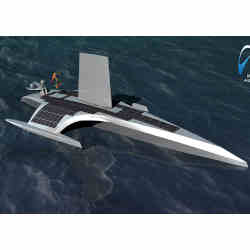
In 1620, the Puritans set sail on the Mayflower from Plymouth, England, for the New World. Four hundred years later, another Mayflower is about to make the same voyage to America, but there will be no Pilgrims on board; instead, this namesake's Atlantic crossing will be solar-powered, and operated by artificial intelligence (AI).
The Mayflower Autonomous Ship (MAS), built by IBM and ProMare, a U.K.-based marine research non-profit, is scheduled to make its initial transatlantic crossing in April. At the helm of the autonomous ship will be the AI Captain, which pulls together data from the ship's computer vision system, sonar, radar, Automatic Identification System (AIS), depth sensor, GPS, navigation system, propulsion system, and batteries, as well as weather data, in order to maintain complete situational awareness.
Underpinning the AI Captain's decision-making capabilities is a piece of automation software called Operational Decision Manager (ODM), which assimilates all available data and assesses it against maritime collision regulations. The system then chooses the optimal route safest for other vessels and for MAS, while completing its mission in the most efficient way.
IBM's Edge computing enables the autonomy required for continuous operations in the middle of the ocean. Edge devices provide enough compute power for MAS to operate independently, and for the AI Captain to function even without network connectivity. When a connection with the cloud is made, performance data is uploaded, system updates are downloaded, and MAS's autonomous system continues.
"Ten years ago, building an autonomous ship capable of sailing across the Atlantic would simply not have been possible," says Andy Stanford-Clark, IBM's chief technical officer for England and Ireland, "but with the development of AI and edge computing technologies, we feel confident that we can pull this off."
Autonomous shipping is a nascent industry, with efforts extending beyond just automating ships. For instance, ONE SEA is an alliance of companies that includes ABB, Kongsberg, Wärtsilä, Cargotec, and Inmarsat, that are acting together to set up an autonomous maritime test area off the coast of Finland. ONE SEA's mission is to help usher in the digital era in the marine industry, from ports and cargo handling to retrofitting ships and building new ones.
"The digitalization of maritime logistics chains through autonomous ships, safer navigation lanes, and smart ports is expected to not only bring operational savings, but increase safety by reducing accidents caused by human error," says Päivi Haikkola of ONE Sea.
Human error is one of the leading causes of maritime incidents, according to Andrew Kinsey, Senior Marine Risk Consultant at Allianz Global Corporate & Specialty, a German insurance company that tracks the maritime industry. "According to Allianz's annual Safety And Shipping Review, it is estimated that 75% to 96% of marine accidents can involve human error, so one of the main arguments for automation is that it could make vessels safer at sea," Kinsey asserts.
Other potential benefits, Kinsey says, include increasing productivity and efficiencies, such as savings on crew and fuel costs, as well as making logistics easier and potentially enhancing safety. Automated shipping lanes could increase the reliability of cargo transport, while unmanned vessels could also lead to a decline in piracy incidents, given there would be no crew to be used as ransom leverage.
On the other hand, Kinsey thinks emergencies and environmental issues could also pose threats in the absence of crew, while management of cargo and incidents such as fires could also prove challenging without appropriate crew support. In addition, cyber risk would likely increase, given the growing use of connected technology in the maritime sector.
However, Kinsey is not certain how quickly this new technology might be adopted by the shipping industry, no matter how compelling the returns might be. "I believe we are going to be seeing vessel operators trying to save money in the short- and mid-term, not spend on new and unproven technology."
Michael Johnson, founder and CEO of Sea Machines, a provider of autonomous vessel software and systems, sees other factors slowing the adoption of autonomous technologies. "The primary barrier is that this is a completely new technology in a space that has been operating using similar methods for a couple of hundred years," Johnson says.
As a result, he says, "One of our challenges is finding progressive operators that will stick their toe in the water first and go up against the norm."
Johnson was involved in the salvage of the Costa Concordia, the Carnival cruise ship that struck a rock, capsized, and foundered off the coast of Italy in January 2012. At the time, he recalls, "I recognized that we needed to bring intelligent command and control systems into the industry to make operations more predictable and safer, along with improvements in productivity and efficiency." He co-founded Boston-based Sea Machines in 2015 to develop and productize intelligent command and control systems for fleets of commercial and naval vessels.
In order to get up and running quickly, Sea Machines leveraged off-the-shelf hardware and sensors, and added intelligent algorithms to autonomously control vessels. "We used marine radar for situational awareness, and an automatic identification system (AIS) beacon system as well," Johnson says. "With off-the-shelf sensors, you are mostly limited to managed or controlled domains, very much like an automated Amazon warehouse."
Sea Machines finds value in the workboat sector (task-driven vessels like ferries and tugboats), as well as vessels doing data collection, oil spill response, security, and dredging support operations. The company now is focused on computer vision as a new type of sensor for vessels operating on water, Johnson says. "We believe you can greatly increase your confidence of seeing, understanding, and targeting vessels and obstacles in your operating domain, reducing uncertainty."
Johnson believes the quest is moving outside of the controlled domain and operating over the horizon, just as IBM's Mayflower Autonomous Ship will do on its maiden voyage.
John Delaney is a freelance writer based in New York City, NY, USA.



Join the Discussion (0)
Become a Member or Sign In to Post a Comment